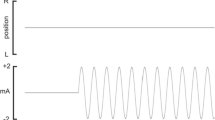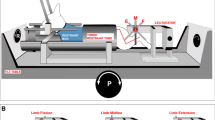Abstract
The dorsolateral reticular formation of the caudal medulla, the lateral tegmental field (LTF), participates in generating vomiting. LTF neurons exhibited complex responses to vestibular stimulation in decerebrate cats, indicating that they received converging inputs from a variety of labyrinthine receptors. Such a convergence pattern of vestibular inputs is appropriate for a brain region that participates in generating motion sickness. Since responses of brainstem neurons to vestibular stimulation can differ between decerebrate and conscious animals, the current study examined the effects of whole-body rotations in vertical planes on the activity of LTF neurons in conscious felines. Wobble stimuli, fixed-amplitude tilts, the direction of which moves around the animal at a constant speed, were used to determine the response vector orientation, and also to ascertain whether neurons had spatial–temporal convergence (STC) behavior (which is due to the convergence of vestibular inputs with different spatial and temporal properties). The proportion of LTF neurons with STC behavior in conscious animals (25 %) was similar to that in decerebrate cats. Far fewer neurons in other regions of the feline brainstem had STC behavior, confirming findings that many LTF neurons receive converging inputs from a variety of labyrinthine receptors. However, responses to vertical plane vestibular stimulation were considerably different in decerebrate and conscious felines for LTF neurons lacking STC behavior. In decerebrate cats, most LTF neurons had graviceptive responses to rotations, similar to those of otolith organ afferents. However, in conscious animals, the response properties were similar to those of semicircular canal afferents. These differences show that higher centers of the brain that are removed during decerebration regulate the labyrinthine inputs relayed to the LTF, either by gating connections in the brainstem or by conveying vestibular inputs directly to the region.






Similar content being viewed by others
References
Anderson JH, Blanks RHI, Precht W (1978) Response characteristics of semicircular canal and otolith systems in the cat. I. Dynamic responses of primary vestibular fibers. Exp Brain Res 32:491–507
Baker J, Goldberg J, Hermann G, Peterson B (1984) Spatial and temporal response properties of secondary neurons that receive convergent input in vestibular nuclei of alert cats. Brain Res 294:138–143
Balaban CD (1996) Vestibular nucleus projections to the parabrachial nucleus in rabbits: implications for vestibular influences on the autonomic nervous system. Exp Brain Res 108:367–381
Balaban CD (1999) Vestibular autonomic regulation (including motion sickness and the mechanism of vomiting). Curr Opin Neurol 12:29–33
Barman SM, Gebber GL (1987) Lateral tegmental field neurons of cat medulla: a source of basal activity of ventrolateral medullospinal sympathoexcitatory neurons. J Neurophysiol 57:1410–1424
Barman SM, Gebber GL, Orer HS (2000) Medullary lateral tegmental field: an important source of basal sympathetic nerve discharge in the cat. Am J Physiol Regul Integr Comp Physiol 278:R995–R1004
Barman SM, Sugiyama Y, Suzuki T, Cotter LA, DeStefino VJ, Reighard DA, Cass SP, Yates BJ (2011) Rhythmic activity of neurons in the rostral ventrolateral medulla of conscious cats: effect of removal of vestibular inputs. Am J Physiol Regul Integr Comp Physiol 301:R937–R946
Berman AI (1968) The brain stem of the cat. University of Wisconsin Press, Madison
Bolton PS, Goto T, Schor RH, Wilson VJ, Yamagata Y, Yates BJ (1992) Response of pontomedullary reticulospinal neurons to vestibular stimuli in vertical planes. Role in vertical vestibulospinal reflexes of the decerebrate cat. J Neurophysiol 67:639–647
Borison HL, Wang SC (1949) Functional localization of central coordinating mechanism for emesis in cat. J Neurophysiol 12:305–313
Cheung BS, Money KE, Jacobs I (1990) Motion sickness susceptibility and aerobic fitness: a longitudinal study. Aviation Space Environ Med 61:201–204
Correia MJ, Guedry FE Jr (1966) Modification of vestibular responses as a function of rate of rotation about an Earth-horizontal axis. Acta Otolaryngol 62:297–308
DeStefino VJ, Reighard DA, Sugiyama Y, Suzuki T, Cotter LA, Larson MG, Gandhi NJ, Barman SM, Yates BJ (2011) Responses of neurons in the rostral ventrolateral medulla (RVLM) to whole-body rotations: comparisons in decerebrate and conscious cats. J Appl Physiol 110:1699–1707
Fernandez C, Goldberg JM (1971) Physiology of peripheral neurons innervating semicircular canals of the squirrel monkey. II. Response to sinusoidal stimulation and dynamics of peripheral vestibular system. J Neurophysiol 34:661–675
Fernandez C, Goldberg JM (1976) Physiology of peripheral neurons innervating otolith organs of the squirrel monkey. III. Response dynamics. J Neurophysiol 39:996–1008
Fukuda H, Koga T (1991) The Botzinger complex as the pattern generator for retching and vomiting in the dog. Neurosci Res 12:471–485
Fukuda H, Koga T (1992) Non-respiratory neurons in the Botzinger complex exhibiting appropriate firing patterns to generate the emetic act in dogs. Neurosci Res 14:180–194
Golding JF (2006) Motion sickness susceptibility. Auton Neurosci 129:67–76
Guedry FE Jr (1965) Orientation of the rotation-axis relative to gravity: its influence on nystagmus and the sensation of rotation. Acta Otolaryngol 60:30–48
Herbert H, Moga MM, Saper CB (1990) Connections of the parabrachial nucleus with the nucleus of the solitary tract and the medullary reticular formation in the rat. J Comp Neurol 293:540–580
Kasper J, Schor RH, Wilson VJ (1988) Response of vestibular neurons to head rotations in vertical planes. I. Response to vestibular stimulation. J Neurophysiol 60:1753–1764
Koga T, Qu R, Fukuda H (1998) The central pattern generator for vomiting may exist in the reticular area dorsomedial to the retrofacial nucleus in dogs. Exp Brain Res 118:139–147
Miller AD, Wilson VJ (1983) Vestibular-induced vomiting after vestibulocerebellar lesions. Brain Behav Evol 23:26–31
Miller AD, Nonaka S, Jakus J (1994) Brain areas essential or non-essential for emesis. Brain Res 647:255–264
Miller DM, Cotter LA, Gandhi NJ, Schor RH, Cass SP, Huff NO, Raj SG, Shulman JA, Yates BJ (2008a) Responses of caudal vestibular nucleus neurons of conscious cats to rotations in vertical planes, before and after a bilateral vestibular neurectomy. Exp Brain Res 188:175–186
Miller DM, Cotter LA, Gandhi NJ, Schor RH, Huff NO, Raj SG, Shulman JA, Yates BJ (2008b) Responses of rostral fastigial nucleus neurons of conscious cats to rotations in vertical planes. Neuroscience 155:317–325
Money KE (1970) Motion sickness. Physiol Rev 50:1–39
Moy JD, Miller DJ, Catanzaro MF, Boyle BM, Ogburn SW, Cotter LA, Yates BJ, McCall AA (2012) Responses of neurons in the caudal medullary lateral tegmental field to visceral inputs and vestibular stimulation in vertical planes. Am J Physiol Regul Integr Comp Physiol 303:R929–R940
Orer HS, Barman SM, Gebber GL, Sykes SM (1999) Medullary lateral tegmental field: an important synaptic relay in the baroreceptor reflex pathway of the cat. Am J Physiol 277:R1462–R1475
Orer HS, Gebber GL, Phillips SW, Barman SM (2004) Role of the medullary lateral tegmental field in reflex-mediated sympathoexcitation in cats. Am J Physiol Regul Integr Comp Physiol 286:R451–R464
Reason JT (1978) Motion sickness adaptation: a neural mismatch model. J R Soc Med 71:819–829
Schor RH, Angelaki DE (1992) The algebra of neural response vectors. Ann New York Acad Sci 656:190–204
Schor RH, Miller AD, Tomko DL (1984) Responses to head tilt in cat central vestibular neurons. I. Direction of maximum sensitivity. J Neurophysiol 51:136–146
Scudder CA, Kaneko CS, Fuchs AF (2002) The brainstem burst generator for saccadic eye movements: a modern synthesis. Exp Brain Res 142:439–462
Sugiyama Y, Suzuki T, Destefino VJ, Yates BJ (2011) Integrative responses of neurons in nucleus tractus solitarius to visceral afferent stimulation and vestibular stimulation in vertical planes. Am J Physiol Regul Integr Comp Physiol 301:R1380–R1390
Suzuki T, Sugiyama Y, Yates BJ (2012) Integrative responses of neurons in parabrachial nuclei to a neurogenic gastrointestinal stimulus and vestibular stimulation in vertical planes. Am J Physiol Regul Integr Comp Physiol 302:R965–R975
Wang SC, Borison HL (1951) The vomiting center; its destruction by radon implantation in dog medulla oblongata. Am J Physiol 166:712–717
Yates BJ (2009) Motion sickness. In: Binder MD, Hirokawa N, Windhorst U (eds) Encyclopedia of neuroscience. Springer, Heidelberg, pp 2410–2413
Yates BJ, Balaban CD, Miller AD, Endo K, Yamaguchi Y (1995) Vestibular inputs to the lateral tegmental field of the cat: potential role in autonomic control. Brain Res 689:197–206
Yates BJ, Miller AD, Lucot JB (1998) Physiological basis and pharmacology of motion sickness: an update. Brain Res Bull 47:395–406
Acknowledgments
The authors thank Lucy Cotter for technical assistance. Funding was provided by Grant R01-DC003732 from the National Institutes of Health (USA).
Author information
Authors and Affiliations
Corresponding author
Rights and permissions
About this article
Cite this article
McCall, A.A., Moy, J.D., DeMayo, W.M. et al. Processing of vestibular inputs by the medullary lateral tegmental field of conscious cats: implications for generation of motion sickness. Exp Brain Res 225, 349–359 (2013). https://doi.org/10.1007/s00221-012-3376-1
Received:
Accepted:
Published:
Issue Date:
DOI: https://doi.org/10.1007/s00221-012-3376-1




